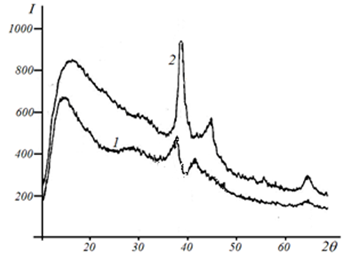- Submissions

Full Text
Polymer Science: Peer Review Journal
Metallo Nanocomposites in the Matrix of Copolymer of 1-Vinyl-1,2,4, -Triazole with Methacrylic Acid
Sargsyan SH1*, Sargsyan AS2, Khizantsyan KM1, Sargsyan TS2, Margaryan KS2 and Aghajanyan IG
1National Polytechnic University of Armenia, Armenia
2Yerevan State Medical University after Mkhitar Heratsi, Armenia
*Corresponding author: Serzhik Sargsyan, National Polytechnic University of Armenia, Armenia
Submission: January 05, 2022;Published: January 12, 2022

ISSN: 2770-6613 Volume2 Issue5
Opinion
For medicine, nanophotonics, and catalysis, nanocomposite materials with silver nanoparticles are necessary and their use in these areas is promising [1]. In modern chemical science, electrosynthesis and the study of the properties of functional polymers and nanomaterials based on them are the most rapidly developing areas. Nanomaterials in medicine are used as antibacterial drugs, biosensors, drug delivery systems, etc. [2,3]. The process of electrosynthesis of metal-polymer nanocomposites and coatings on pure iron and steel electrodes was investigated by combining the electrochemical (co) polymerization of solid solution with methacrylic acid with the cathodic release of metals. During electrolysis in the presence of AgNO3 and chitosan of aqueous or aqueous-ethanol solutions of 1-vinyl- 1,2,4-triazole methacrylic acid (VT-MA), their mixtures in various ratios and in the presence of an initiator, for example, 4-tert-butylperoxy-4-oxobutanoic acid (TBOBA), the potential of electroreduction of which during cathodic metal release is 0.6-1.2V (c.s.e.), nanocomposites and nanocomposite coatings with a silver content of 1-10 wt% are formed. In the electronic spectra of silver-containing nanocomposites, in contrast to aqueous solutions of the initial copolymers and AgNO3, plasmon absorption bands appear with a maximum in the region of nanocomposite coatings containing silver. Absorption bands with a maximum appear in the region of 413-420nm. This is typical for systems with isolated nanoparticles of metallic silver (Figure 1, curve 2).
Figure 1: Electronic absorption spectra of VT-MA copolymer [1] and polymer nanocomposite of silver (8.3%) [2].

In the IR spectra of VT-MA copolymers, bands appear corresponding to the frequencies of stretching bending vibrations of the triazole ring 1503, 1434, 1138, 1005, 660cm-1 (C-N, C=N), 1275cm-1 (NN), 3106cm-1 (CN) and a band at 1714cm-1, related to stretching vibrations of the units of the carboxyl group. According to elemental analysis and atomic absorption spectroscopy, the silver content in nanocomposite films is 1-10% (Table 1). The formation of organo-inorganic nanocomposites, namely, the presence of silver nanoparticles and an amorphous polymer phase, is confirmed by the results of X-ray analysis. The X-ray diffraction patterns of nanocomposites (Figures 2 & 3) clearly differentiate the amorphous polymer component and intense reflections of metal nanoparticles characteristic of the planes of the crystalline phase of zero-valent silver.
Figure 2: Organo-inorganic nanocomposites.

Figure 3: Diffraction patterns of nanocomposites 1 and 2, I - intensity (from. Units), 2-Bragg angle (deg).

Table 1: Nanocomposites based on VT-MA copolymers.

References
- Wang R (2004) The chemistry of nanomaterials. In: Rao CNR, Müller A, Cheetham AK (Eds.), Colloid Polym Sci, WILEY-VCH Verlag GmbH & Co. KGaA, Weinheim, Germany, P: 283: 234.
- Noroozi M, Zakaria A, Moksin MM, Wahab ZA, Abedini A (2012) Green formation of spherical and dendritic silver nanostructures under microwave irradiation without reducing agent. Int J Mol Sci 13(7): 8086-8096.
- Sargsyan SH, Margaryan KS (2014) Formation of composite polymeric coatings on pure iron. Russian Journal of General Chemistry 84: 550-551.
© 2022 Serzhik Sargsyan. This is an open access article distributed under the terms of the Creative Commons Attribution License , which permits unrestricted use, distribution, and build upon your work non-commercially.
 a Creative Commons Attribution 4.0 International License. Based on a work at www.crimsonpublishers.com.
Best viewed in
a Creative Commons Attribution 4.0 International License. Based on a work at www.crimsonpublishers.com.
Best viewed in 







.jpg)






























 Editorial Board Registrations
Editorial Board Registrations Submit your Article
Submit your Article Refer a Friend
Refer a Friend Advertise With Us
Advertise With Us
.jpg)






.jpg)














.bmp)
.jpg)
.png)
.jpg)










.jpg)






.png)

.png)



.png)






